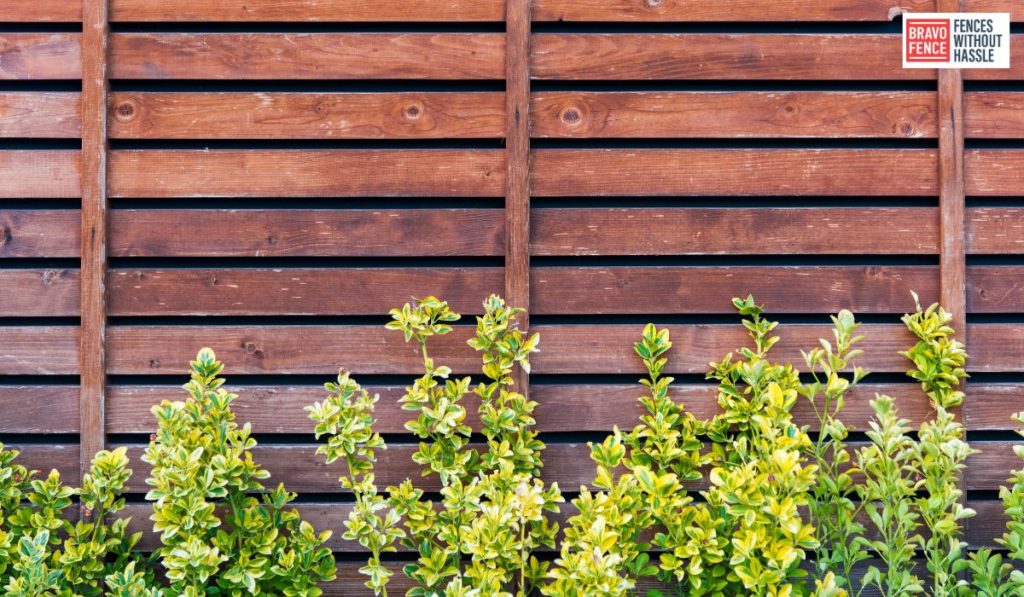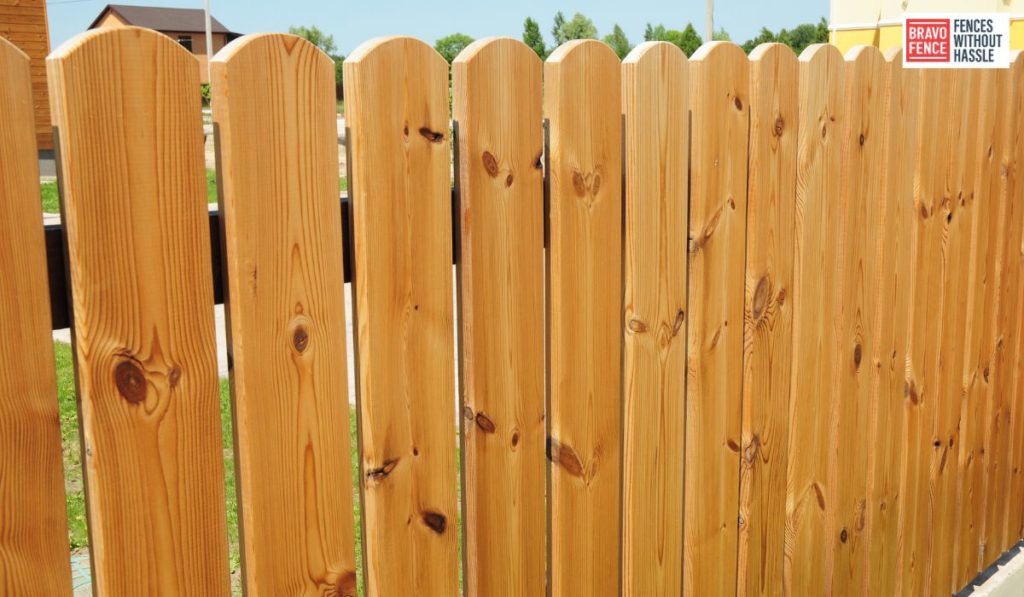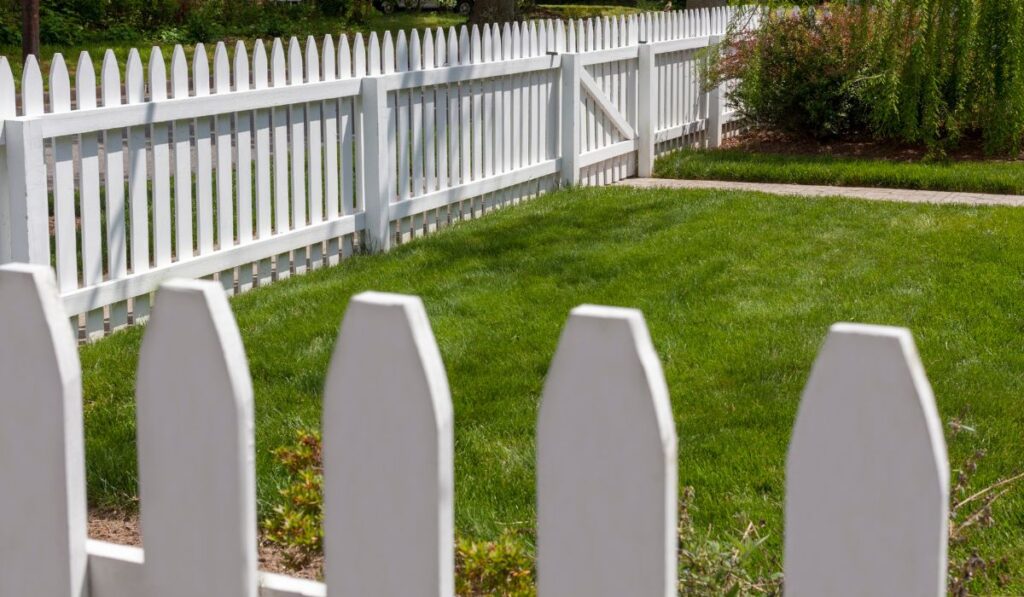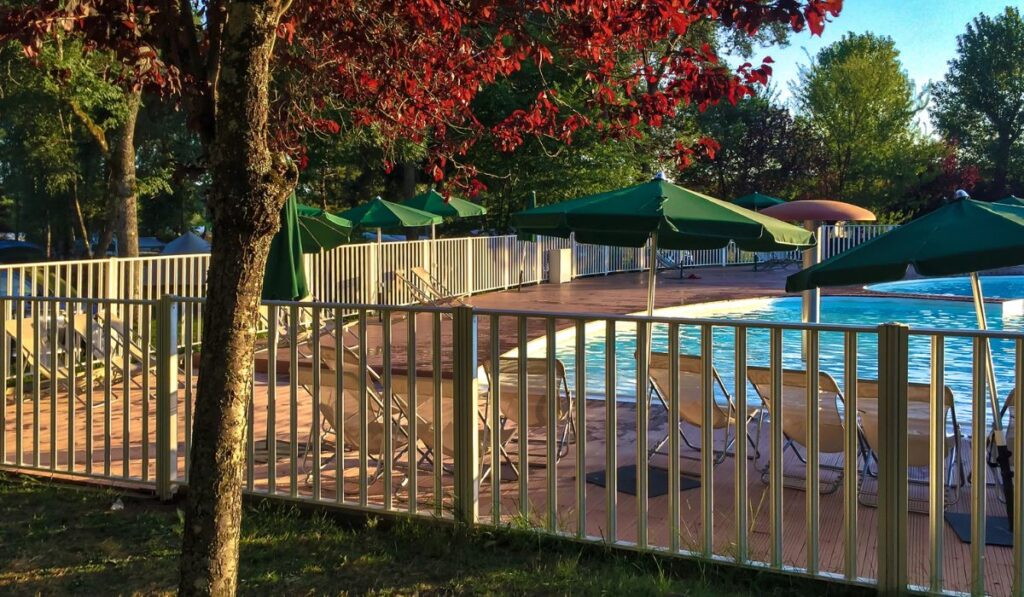The horizontal wood fence has gained significant popularity among homeowners and designers in recent years. Its sleek and contemporary look has captivated many, making it a big hit in 2023. A horizontal wood fence offers a refreshing alternative to traditional vertical fence designs, adding a modern touch to any outdoor space.
How Does a Horizontal Wood Fence Differ From A Vertical Fence?
The main difference between a horizontal wood fence and a vertical fence lies in its orientation. While a vertical fence consists of upright boards aligned vertically, a horizontal wood fence features boards positioned horizontally. This simple distinction brings a new aesthetic to the design, setting it apart from the conventional fencing options.
Pros And Cons Of Installing A Horizontal Wood Fence
Like any other fencing option, a horizontal wood fence has its own advantages and disadvantages. Let’s take a closer look at what makes it an appealing choice for many homeowners and some considerations to keep in mind before installation.
Pros of Horizontal Wood Fence
- Modern Appeal: A horizontal wood fence adds a contemporary and stylish touch to your outdoor space, making it visually appealing and on-trend.
- Enhanced Privacy: With the boards positioned horizontally, a wood fence provides excellent privacy, shielding your yard from prying eyes.
- Increased Security: The sturdy construction of a horizontal wood fence is a deterrent to potential intruders, enhancing the security of your property.
- Versatility: Horizontal wood fences can be customized to match various architectural styles, allowing for seamless integration with your home’s aesthetics.
- Better Wind Resistance: The horizontal orientation of the boards reduces the wind resistance, making it a suitable option for areas prone to strong gusts.

Cons of Horizontal Wood Fence
- Maintenance: Wood fences require regular maintenance, including staining or painting, to protect them from weathering and extend their lifespan.
- Potential for Warping: Horizontal wood boards are more prone to warping than their vertical counterparts. Proper installation and occasional maintenance can help mitigate this issue.
- Cost: Horizontal wood fences may be more expensive than other fencing options due to the additional materials required and the labor-intensive installation process.
Popular Types Of Horizontal Wood Fences
Horizontal wood fences offer a wide range of design possibilities. Here are some popular types to consider:
Split-rail fences
Split-rail fences are a classic choice for a rustic and natural look. They consist of horizontal wooden rails supported by sturdy posts, offering your outdoor space an open and airy feel.
Shadowbox-style fences
Shadowbox-style fences feature overlapping horizontal boards, creating an alternating pattern that offers privacy and a visually appealing design. This style is perfect for those seeking a balance between openness and seclusion.
Picket fences
Picket fences, typically associated with vertical designs, can be adapted to a horizontal configuration. Horizontal picket fences give a fresh and modern twist to the traditional charm of picket-style fencing.
Privacy panels/boards on battens
Privacy panels or boards mounted on battens provide a clean and contemporary appearance. This style offers maximum privacy while maintaining an open feel through the gaps between the boards.
How To Build A Horizontal Fence?
Building a horizontal wood fence requires careful planning and execution. Follow these steps to create a beautiful and sturdy wall:
Prepare the site and dig postholes.
Start by marking the fence line and clearing the area. Use a posthole digger to create holes for the fence posts, ensuring they are evenly spaced and at a consistent depth.
Install the posts and rails (or boards)
Place the fence posts in the holes and secure them with concrete. Ensure the posts are level and aligned correctly. Once the posts are set, attach horizontal rails or boards to create the framework for the fence.
Connect top and bottom railings or boards.
Attach the top and bottom railings or boards to the fence posts, ensuring they are level and securely fastened. This step provides structural stability to the fence.
Secure the posts with concrete.
After the posts are in position and the rails or boards are attached, fill the postholes with concrete for added stability. Allow the concrete to cure according to the manufacturer’s instructions.
Attach boards or panels to the frame.
Finally, attach the horizontal boards or panels to the fence’s framework, securing them firmly. Ensure they are evenly spaced and level, creating a visually pleasing and functional wall.
Add decorative features if desired.
To enhance the aesthetics of your horizontal wood fence, consider adding decorative features such as trim boards, lattice panels, or post caps. These elements can elevate the overall look and add a personalized touch.
Horizontal Fence Design – Top Picks Of 2023
If you’re seeking design inspiration for your horizontal wood fence, here are some top picks for 2023:
- Contemporary Cedar: A sleek cedar fence with clean lines and minimalist design is an excellent choice for a modern aesthetic.
- Dark-Stained Elegance: Opt for a dark-stained wood fence to create a striking contrast against your landscape, giving a touch of elegance to your outdoor space.
- Mixed Materials: Combine horizontal wood boards with other materials like metal or glass for a unique and eye-catching fence design.
- Painted Panache: Experiment with vibrant colors to make a bold statement with your horizontal wood fence, adding personality to your property.
- Board-on-Board Beauty: Create a visually appealing design by overlapping the horizontal boards slightly, showcasing a layered effect.
Is Wood The Only Option For Horizontal Fencing?
While wood is a popular choice for horizontal fencing due to its natural beauty and versatility, it’s not the only option available. Alternative materials such as composite boards, metal panels, or vinyl can also achieve a horizontal fence design. Each material has unique characteristics, offering different levels of durability, maintenance requirements, and aesthetic appeal. Consider your specific needs and preferences before making a decision.
Maintenance Tips For Horizontal Fence
To ensure the longevity and beauty of your horizontal wood fence, follow these maintenance tips:
- Regular Cleaning: Remove debris, dirt, and leaves from your bar regularly. Use a soft brush or a gentle pressure wash to clean the surface.
- Stain or Paint: Apply a protective color or paint every few years to prevent weathering and keep the wood in good condition.
- Inspect for Damage: Periodically inspect your fence for any signs of damage, such as rot, warping, or lose boards. Repair or replace damaged sections promptly.
- Trim Vegetation: Trim any overgrown vegetation near the fence to prevent it from touching and potentially damaging the wood.
- Protect from Moisture: Ensure proper drainage around the wall to prevent water from pooling near the base, which can lead to rot and deterioration.
Choosing Bravo Fence Company For Your Horizontal Fencing Needs
Choosing the right fencing company is crucial when installing a horizontal wood fence. Bravo Fence Company is a trusted and reputable provider of high-quality fencing solutions. With their expertise and commitment to customer satisfaction, Bravo Fence Company ensures a seamless and professional installation process. Transform your outdoor space with their comprehensive design options and superior craftsmanship.
FAQs
Are horizontal wood fences more expensive?
The cost of a horizontal wood fence can vary depending on the type of wood, fence dimensions, additional features, and labor costs. While horizontal wood fences may be slightly more expensive than other options, they offer a unique aesthetic appeal and durability that make them worth the investment.
What kind of wood should I use for a horizontal fence?
Choosing the wood for your horizontal fence ensures its longevity and performance. Durable and rot-resistant wood species like cedar, redwood, or tropical hardwoods like ipe are popular. These woods have natural oils and tannins that protect against decay and insect damage.

Is it cheaper to do a horizontal or vertical fence?
The cost of a fence depends on various factors, including the materials used, labor costs, and fence design. Generally, horizontal and vertical walls can have similar prices. However, factors such as the type of wood, additional features, and the complexity of the design can influence the overall cost.
Do horizontal or vertical fences last longer?
Both horizontal and vertical fences can have a long lifespan when properly maintained. However, horizontal wood fences may be more prone to warping due to how the boards are oriented. Regular maintenance, including staining or painting and addressing any signs of damage, can help prolong the lifespan of both fences.
Do horizontal fences need gaps?
Gaps between horizontal fence boards are recommended for airflow and to prevent moisture buildup, which can lead to decay. The size of the holes may vary depending on your desired level of privacy and the wood’s natural expansion and contraction due to weather changes.
Do you need to leave a gap between horizontal fence boards?
Yes, leaving a small gap between horizontal fence boards allows for natural expansion and contraction of the wood due to weather changes. This helps prevent warping and maintains the overall integrity of the fence.
How far apart should fence posts be for a horizontal fence?
The spacing of fence posts for a horizontal fence depends on various factors, including the type of wood, fence height, and local building codes. As a general guideline, posts should be spaced approximately 6 to 8 feet apart to ensure sufficient stability and support for the fence.
How do you keep a horizontal fence from sagging?
Proper construction and installation techniques are essential to prevent sagging in a horizontal fence. Ensure the fence posts are securely set in concrete and properly aligned. Additionally, using sturdy horizontal rails or boards and reinforcing the structure with diagonal bracing can help maintain the fence’s integrity and prevent sagging over time.
How many boards do I need for a horizontal fence?
The number of boards needed for a horizontal fence depends on the desired fence height, spacing between panels, and the total length of the wall. Please measure the size of your bar and calculate the number of boards required based on the desired spacing between them.
How wide should horizontal fence boards be?
The width of horizontal fence boards can vary depending on personal preference and the desired aesthetic. Standard widths range from 4 to 8 inches. Consider the overall design and balance of your fence when choosing the width of the boards.
Conclusion
A horizontal wood fence offers a contemporary and stylish solution to enhance your outdoor space. Its modern appeal, privacy, and versatility make it a popular choice among homeowners. You can enjoy a beautiful and durable fence that complements your property by following the right design, construction, and maintenance practices. Upgrade your outdoor aesthetics with a horizontal wood fence and create a stunning backdrop for outdoor activities.






